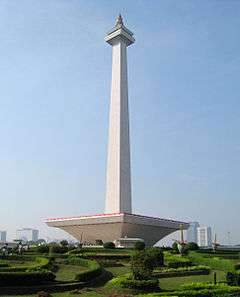National monument

.jpg)
A national monument is a monument constructed in order to commemorate something of national importance such as the country's founding, independence or a war.
The term may also refer to a specific monument status, such as a national heritage site, which most national monuments are by reason of their cultural importance rather than age. The National monument aims to represent the nation, and serve as a focus for national identity.
Overview
A series of structures or areas deemed to be of national importance and therefore afforded protection by the state are part of a country's cultural heritage. These national heritage sites are often called something different per country and are listed by national conservation societies. Romania has listed at least one plant as a national monument, Nymphaea lotus f. thermalis.[1]
Example
National monument
- The National Monument (Indonesia)
- The Pakistan Monument (Islamabad)
- Jatiyo Smriti Soudho (National Martyr's Memorial), Bangladesh
- The National Monument (Malaysia)
- The Netherlands National Monument (Amsterdam)
- The National Monument of Scotland (Edinburgh)
National heritage sites
- National Monuments of Colombia
- National monuments of Ireland
- National monuments of Portugal
- National monuments of Singapore
- National monuments of Spain
- National monuments of the United States
References
- ↑ Veler, Ana (November 2008). "Nymphaea lotus up north, naturally". Water Gardeners International. Bucharest, Romania. 3 (4). Retrieved 9 August 2014.
See also
- National heritage sites of South Africa
- National icon
- National memorial
- National Monument (United States)